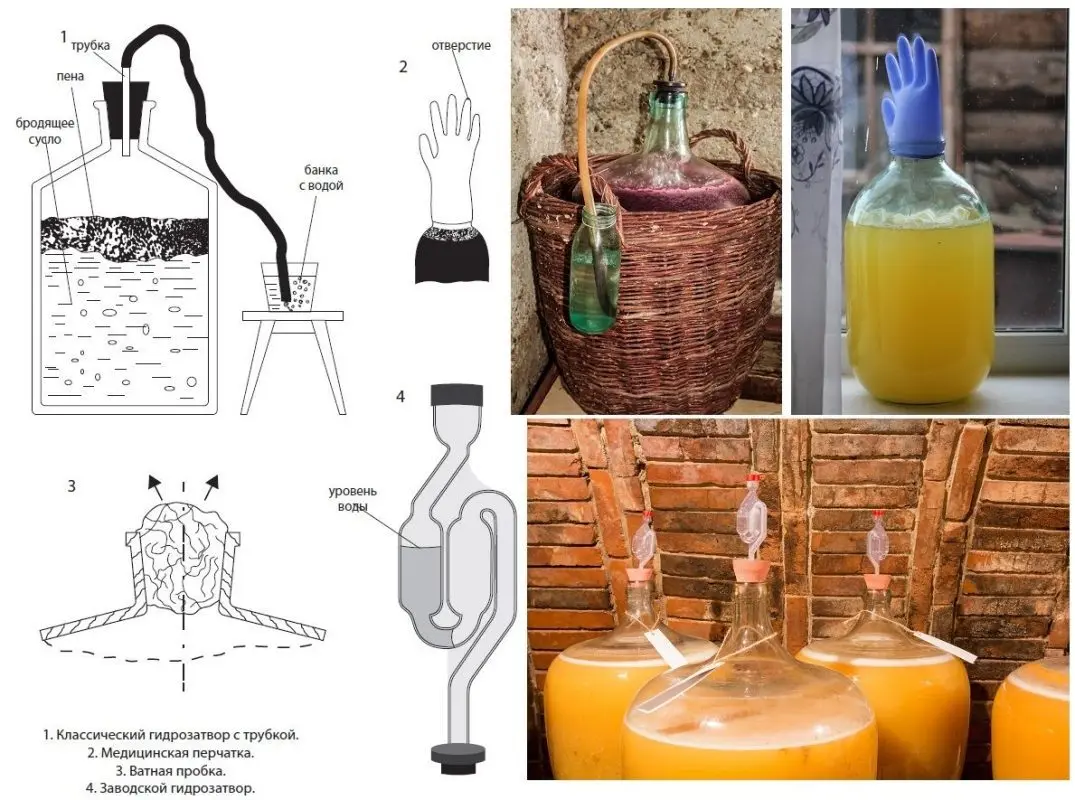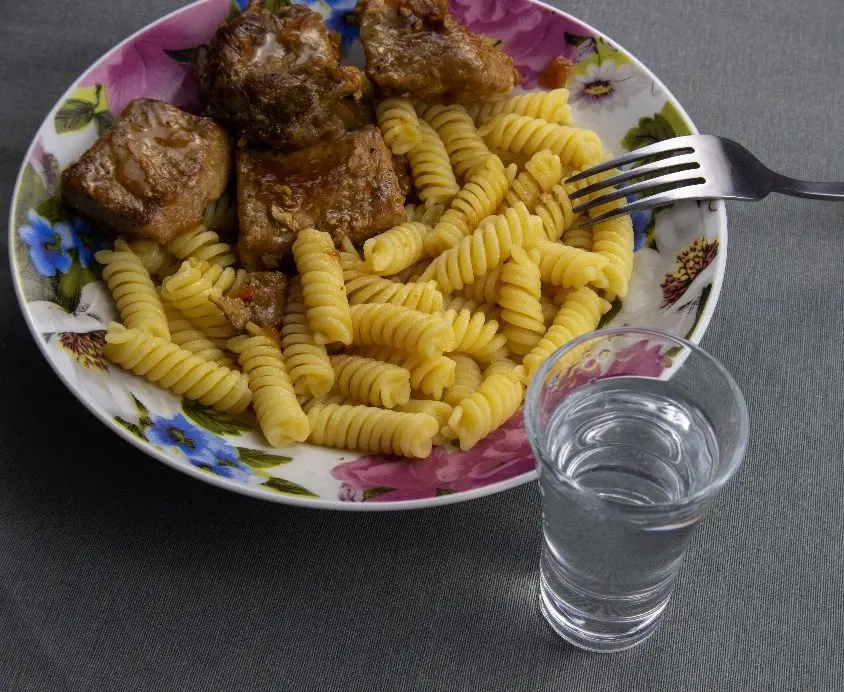Contents
Properly made moonshine from pasta is practically no different from other grain drinks and resembles soft wheat moonshine. This is a great way to recycle old stock that is no longer edible. Any varieties and types of pasta will do: hard, soft, long, short, curly, etc. You can mix different pasta in one mash.
Theory
Pasta contains up to 70% starch, which means that the theoretical yield from 1 kg of raw materials is 0,98 liters of forty-degree moonshine, but in practice the yield will be 15-20% lower. The problem is that pasta itself does not ferment, so you first need to break down the starch into simple sugars, this is called saccharification.
There are two methods to obtain sugar from starch: hot saccharification (HOS) with malt (sprouted grain) and cold saccharification (HOS) with enzymes.
In the first case, the yield of moonshine will be greater due to malt (plus 800 ml of 40% vol. from 1 kg) and faster fermentation, but the process itself is laborious and requires precise temperature control. With cold saccharification, labor costs are minimal, however, special yeast with enzymes is required, and the mash plays longer. We will consider both options for making pasta mash and the technology of distillation in a classic distiller.
pasta mash recipe
Ingredients:
- pasta – 4 kg;
- malt (barley or rye) – 1 kg (only for GOS);
- water – 25 l (VOC) or 16 l (VOC);
- yeast Koji Angel – 36 g (9 g per 1 kg of raw materials) only for HOS;
- yeast – 25 g dry, 250 g pressed or alcoholic for 25 liters of wort (only for GOS).
Hot saccharification requires 5 liters of water per 1 kg of raw materials (pasta + malt), for koji mash – 4 liters per 1 kg of pasta.
Macaroni mash with malt (GOS)
Any malt is suitable: both purchased and homemade. I do not recommend using wheat, because the pasta itself is made from wheat flour, and saccharifying raw materials with malt from the same grain is less effective.
1. Boil 30 liters of water in a cooking pot with a capacity of at least 13 liters.
2. Add pasta to boiling water, mix.
3. Cook over medium heat until the pasta is completely boiled, you should get a mass of a homogeneous consistency without lumps. During the cooking process, stir occasionally to avoid burning the raw materials near the bottom and walls of the pan.
4. Add 12 liters of cold water. Mix.
5. Gradually, stirring constantly, add the crushed malt to the pasta.
6. Heat the wort to 62 °C over low heat. Turn off the heat, cover the pan with a lid and leave to saccharify for 90 minutes. During the specified time, maintain the temperature in the range of 55-65 ° C by periodic low heating. It is important not to overheat above 70 ° C, otherwise the enzymes from the malt will irrevocably boil and stop working.
After saccharification, the wort should become sweet, which means that the starch has been successfully broken down into sugar.
7. After 90 minutes, bring the temperature of the wort to 72 °C over low heat, then turn off the heat and cool the wort as quickly as possible to the optimum temperature for adding yeast – 25-26 °C. You can cool the pan in a bath of cold water or ice.
Thanks to this method, it will be possible to go through all the temperature pauses of mashing malt, the protein pause (44-59 ° C) is especially interesting, which reduces the viscosity of the mash and the foam during fermentation.
8. Pour the wort into a fermentation tank, fill to a maximum of 75% of the volume to leave room for foam and carbon dioxide. Add dry, pressed or alcoholic yeast diluted according to the instructions on the sachet.
Attention! If the temperature is above 30 °C, the yeast may die and fermentation will not start.
9. Install a water seal on the tank. Transfer the must to a dark room (or cover) with a stable temperature of 20-28 °C. Leave until the end of fermentation (5-14 days). The finished mash does not release gas from the water seal, is not sweet and is slightly bitter.

Koji Pasta Braga (HOS)
The recipe uses Chinese yeast Koji Angel, but they can be replaced with other similar ones or be made with enzymes using the classic cold saccharification technology.
10. Pre-grind the pasta with a meat grinder or in any other way. The step is optional, but it will help the enzymes to process the raw materials faster and more efficiently, which will increase the yield.
11. Place the pasta in a fermentation container. Pour in 16 liters of water. There should be 15-20% free space in the container in case of active foam. Pour in the Koji Angel yeast.
12. Stir the wort so that the water and yeast are evenly distributed among the pasta, it is much easier to work with chopped products.
13. Install a water seal on the tank. Leave the mash until the end of fermentation in a dark room at a temperature of 20-28 ° C. During the fermentation process, the pasta may rise to the surface and sink to the bottom again, this is normal. Once a day, stir the mash with a wooden rolling pin.
Fermentation of pasta mash on koji lasts 15-25 days. Ready mash does not emit gas from the water seal, you can not taste it.
Getting moonshine from pasta
14. Drain the pasta wash from the sediment into the distillation cube so that the solid particles do not burn during distillation and spoil the taste of moonshine with bitterness.
15. Overtake the mash for the first time at maximum speed without separation into fractions. Take the distillate before the drop of the strength in the jet below 25%.
16. Measure the strength of the resulting moonshine, determine the amount of pure alcohol (multiply the percentage strength by the volume in liters and divide by 100).
17. Dilute the distillate with water to 17-20% vol. and do a second run. Collect the first 10-12% of the amount of pure alcohol separately, this is the harmful “head” fraction.
18. Select the “body” (the main product) until the fortress in the jet falls below 45% vol. Then you can finish the distillation or take the “tails” into a separate container, then pour them into a new portion of the mash before distillation.
19. Dilute the resulting moonshine from pasta (“body”) with water to a drinking strength of 40-45% vol., pour into a glass container and close tightly. Leave for 3-4 days in a dark, cool room to stabilize the taste.










